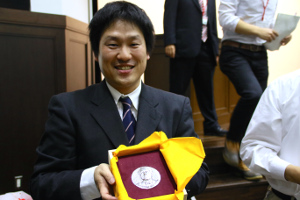 |
|
MPA director Eiichiro Komatsu during the award ceremony.
© Hiroto Kawabata
|
 |
 |
|
The Chushiro Hayashi Prize medal
© Hiroto Kawabata
|
|  |
The Astronomical Society of Japan recognised Eiichiro Komatsu for "Precision
Cosmology based on the Cosmic Microwave Background", the left-over radiation
from the Big Bang at the beginning of the Universe. Komatsu analysed and
interpreted the CMB data that was measured by the WMAP satellite mission, and
in
particular determined the cosmological parameters as well as testing theories
of
inflation.
In analysis of the CMB, it is usually assumed that the small temperature
fluctuations, the signature of the tiny primordial density fluctuations, are
distributed randomly in a Gaussian field. While some inflationary scenarios
predict that the fluctuations should indeed be nearly Gaussian, more complex
models predict deviations from a Gaussian field. The presence of any
non-Gaussian features in the observed CMB are therefore a powerful test for
various inflationary models. Komatsu has done pioneering work on testing
inflation using non-Gaussian features.
From 2001 to 2010, Komatsu worked as a key member of the WMAP team on data
analysis and the theoretical interpretation. He was the first author of some of
the highly cited WMAP papers. One of the important contributions he made was to
show that the distribution of CMB temperatures measured by WMAP obeys Gaussian
statistics to high precision, which provides the strongest evidence for the idea
that the structures in the Universe originated from quantum fluctuations during
inflation.
The Prize is named after Prof. Chushiro Hayashi (1920-2010), who was an
internationally recognised astrophysicist, well known for his contributions to
the nucleosynthesis of the early universe, stellar evolution, and the formation
of Solar System. With his astrophysical calculations he showed that young
stars,
after their proto-star phase, follow a certain track (the Hayashi track)
in
the Hertzsprung-Russell diagram, contracting and decreasing in luminosity while
keeping an almost constant surface temperature until nuclear fusion starts to
produce energy at their core. Closely related to this development is the
Hayashi limit, a zone in the Hertzsprung-Russell diagram, where no stars
in
hydrostatic equilibrium can be found.
|



